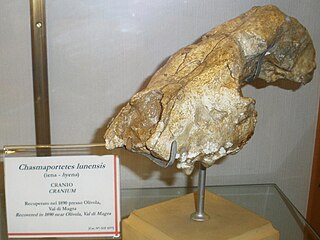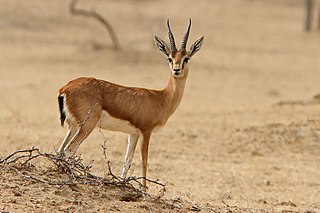
Casablanca,, is the largest city in Morocco and the country's economic and business center. Located on the Atlantic coast of the Chaouia plain in the central-western part of Morocco, the city has a population of about 3.71 million in the urban area, and over 4.27 million in the Greater Casablanca, making it the most populous city in the Maghreb region, and the eighth-largest in the Arab world.

The cheetah is a large cat with a tawny to creamy white or pale buff fur that is marked with evenly spaced, solid black spots. Its head is small and rounded, with a short snout and black tear-like facial streaks. It reaches 67–94 cm (26–37 in) at the shoulder, and the head-and-body length is between 1.1 and 1.5 m. Adults weigh between 21 and 72 kg. It is the fastest land animal, capable of running at 80 to 98 km/h ; it has evolved specialized adaptations for speed, including a light build, long thin legs and a long tail.

Acinonyx is a genus within the Felidae family. The only living species of the genus, the cheetah, lives in open grasslands of Africa and Asia.
The term "big cat" is typically used to refer to any of the five living members of the genus Panthera, namely the tiger, lion, jaguar, leopard, and snow leopard, as well as the non-pantherine cheetah and cougar.

Raja Club Athletic, commonly referred to as Raja CA, Raja Casablanca, RCA or simply RAJA, is a professional football club based in Casablanca, Morocco, that competes in Botola, the top flight of Moroccan football.

The Casablanca Stock Exchange is a stock exchange in Casablanca, Morocco. The Casablanca Stock Exchange (CSE), which achieves one of the best performances in the region of the Middle East and North Africa (MENA), is Africa's third largest stock market after Johannesburg Stock Exchange and Nigerian Stock Exchange in Lagos. It was established in 1929 and currently has 19 members and 81 listed securities with a total market capitalisation of $71.1 billion in 2018.

Chasmaporthetes, also known as hunting or running hyena, is an extinct genus of hyenas distributed in Eurasia, North America, and Africa during the Pliocene-Pleistocene epochs, living from 4.9 million to 780,000 years ago, existing for about 4.12 million years. The genus probably arose from Eurasian Miocene hyenas such as Thalassictis or Lycyaena, with C. borissiaki being the oldest known representative. The species C. ossifragus was the only hyena to cross the Bering land bridge into the Americas, and ranged over what is now Arizona and Mexico during Blancan and early Irvingtonian Land Mammal ages, between 5.0 and 1.5 million years ago.
Nyctereutes abdeslami is an extinct relative of the raccoon dog from the Pliocene. A jaw from the species was found in Morocco. Scientists have noticed that Nyctereutes abdeslami had much larger molars than other species of its genus, suggesting a larger body.

The Northwest African cheetah, also known as the Saharan cheetah, is a cheetah subspecies native to the Sahara and the Sahel. It is listed as Critically Endangered on the IUCN Red List. In 2008, the population was suspected to number less than 250 mature individuals.

Kolpochoerus is an extinct genus of the pig family Suidae related to the modern-day genera Hylochoerus, Phacochoerus, and Potamochoerus. It is believed that most of them inhabited African forests, as opposed to the bushpig and red river hog that inhabit open brush and savannas. There are currently eleven recognized species.
Ahl al Oughlam is an archaeological site and palaeontological site located just outside Casablanca, Morocco. It was discovered in 1985 and first excavated in 1989. Ahl al Oughlam is the richest late Neogene vertebrate locality of North Africa. It has also yielded the area's first important carnivore fauna, including 23 taxa, 13 of which are new.
Gazella psolea is an unusual prehistoric species of gazelle that lived in Africa and Arabia; it is only known from fossils. It makes up the subgenus Deprezia due to its unique skull morphology: it had a long premolar row, and its nasal area is peculiar, with short nasal bones and a very large nasal opening. It therefore seems to have been able to breathe cold and dry air, but why this feature evolved is still rather mysterious. Perhaps it made seasonal migrations to the High Atlas mountains, where such an adaptation would have been useful.

The Asian or Asiatic ostrich, is an extinct species of ostrich that lived during the Neogene period on the Indian subcontinent.

Hicham Aboucherouane is a Moroccan former professional footballer who played as a winger.

Acinonyx pardinensis, sometimes called the Giant cheetah, is an extinct felid species belonging to the genus Acinonyx, closely related to the cheetah, native to Eurasia during the Pliocene and Pleistocene epochs. It was substantially larger than the living cheetah.
Abu al-Rabi Sulayman ibn 'Abd Allah al-Hawwat Shafshawani was a Moroccan historian, biographer and poet.

Ontocetus is an extinct genus of walrus, an aquatic carnivoran of the family Odobenidae, endemic to coastal regions of the southern North Sea and the southeastern coastal regions of the U.S. during the Miocene-Pleistocene. It lived from 13.6 mya—300,000 years ago, existing for approximately 13.3 million years.

A gazelle is one of many antelope species in the genus Gazella. There are also seven species included in two further genera; Eudorcas and Nanger, which were formerly considered subgenera of Gazella. A third former subgenus, Procapra, includes three living species of Asian gazelles.

"Acinonyx kurteni", or the Linxia cheetah, is a discredited fossil specimen of an extinct cheetah discovered in China. The scientific name was assigned for the skull that was originally described to be that of an extinct species of cheetah, endemic to Asia during the Late Pliocene sub-epoch. It was estimated to have lived around 2.2 to 2.5 Ma BP, existing for approximately 0.3 million years.

Ursus etruscus is an extinct species of bear, endemic to Europe, Asia and North Africa during the Pliocene through Pleistocene, living from ~5.3 million to 100,000 years ago.














